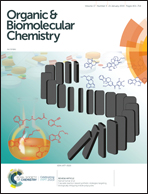Unveiling the high reactivity of cyclohexynes in [3 + 2] cycloaddition reactions through the molecular electron density theory†
Abstract
[3 + 2] cycloaddition (32CA) reactions of cyclohexyne, a cyclic strained acetylene, with methyl azide and methoxycarbonyl diazomethane have been studied within the Molecular Electron Density Theory (MEDT) at the MPWB1K/6-311G(d) computational level. These 32CA reactions, which take place through a one-step mechanism involving highly asynchronous transition state structures, proceed with relatively low activation enthalpies of 6.0 and 4.3 kcal mol−1, respectively, both reactions being strongly exothermic. The reactions are initiated by the creation of a pseudoradical center at one of the two acetylenic carbons of cyclohexyne with a very low energy cost, 1.0 kcal mol−1, which promotes the easy formation of the first C–N(C) single bond in the adjacent acetylenic carbon. This scenario is completely different from that of the 32CA reaction involving non-strained but-2-yne; thus, strain in cyclohexyne triggers a high reactivity as a consequence of its unusual electronic structure at the ground state. Finally, the experimental regioselectivity of the 32CA reactions involving 3-alkoxy-cyclohexyne derivatives is correctly explained within MEDT.
![Graphical abstract: Unveiling the high reactivity of cyclohexynes in [3 + 2] cycloaddition reactions through the molecular electron density theory](/en/Image/Get?imageInfo.ImageType=GA&imageInfo.ImageIdentifier.ManuscriptID=C8OB02568A&imageInfo.ImageIdentifier.Year=2019)
- This article is part of the themed collection: Mechanistic, computational & physical organic chemistry in OBC


 Please wait while we load your content...
Please wait while we load your content...